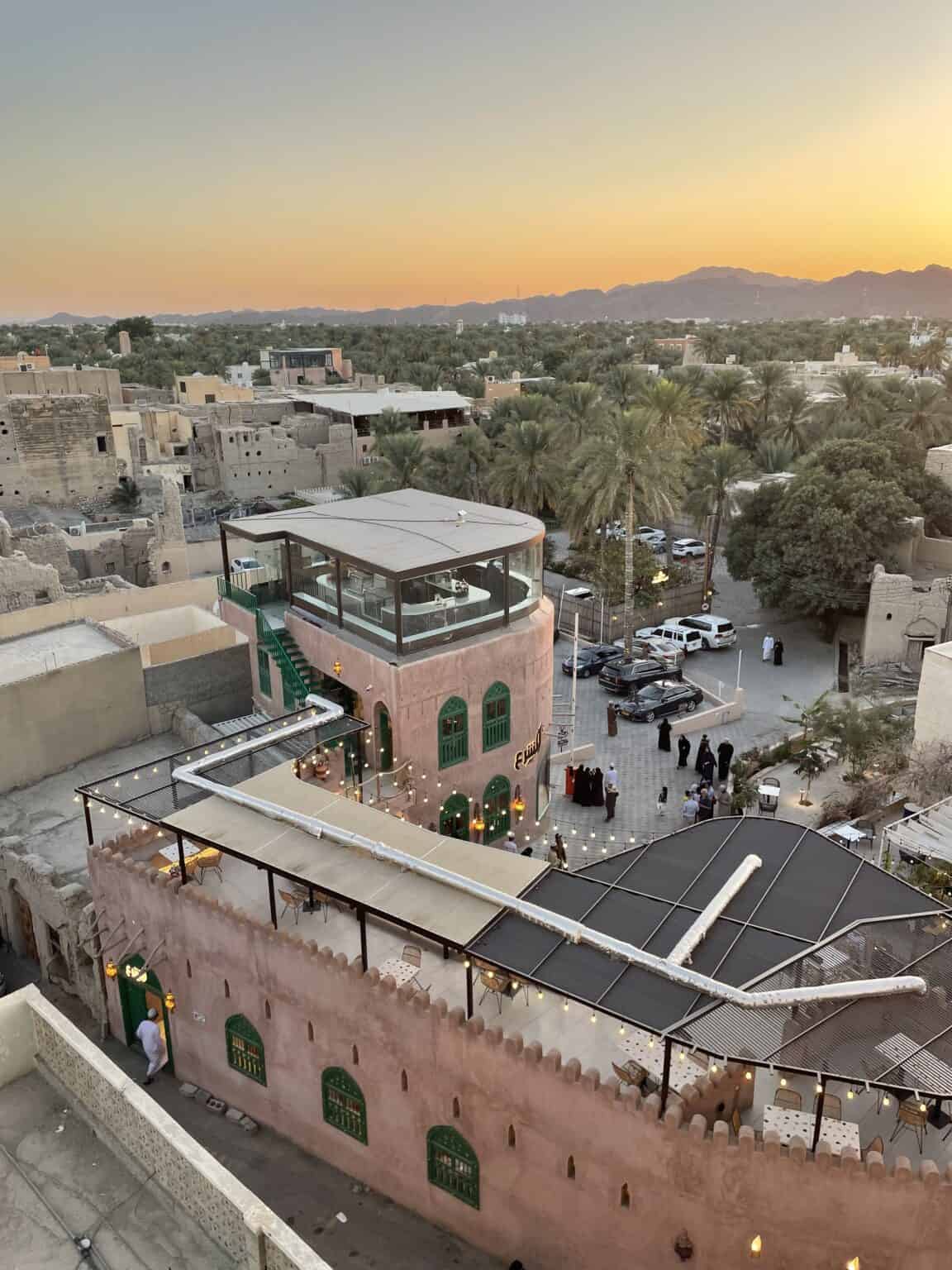
Updated: 12/09/2025

Plan your perfect 7-day trip through Oman’s most unforgettable experiences — from Muscat’s historic souqs to the cool heights of Jabal Akhdar, across the golden dunes of the Wahiba Sands, and along Oman’s spectacular coastline.
I’ve lived in Oman for five years, meandering through its mountain villages, deserts, and coastal towns, and learning directly from Omani people about their traditions, history, and daily life. This insider knowledge means this 7-Day Oman Itinerary blends famous landmarks with authentic local favourites.
Oman offers something unique compared to many of its Gulf neighbours — a slower pace, rich cultural heritage, and dramatic landscapes. It is often underestimated.
Yet, in this 7-day road trip around the North of Oman, you’ll discover why it has been called ‘the jewel of Arabia’.
You’ll start off by discovering the winding alleys of Muttrah Souq and the grandeur of Sultan Qaboos Grand Mosque in Muscat. You’ll also explore the imposing fort of Nizwa, the dramatic mountain landscapes of Jabel Akhdar, and stay at a Beduin-run desert resort in the Wahiba desert (Sharqiya Sands). You’ll even have breakfast in a Fort-like restaurant and wander around a mudbrick village – Birkat Al Mouz – one of my personal favourites – before heading to the coast to swim in turquoise waters and walk along Oman’s pristine beaches, then making your way back to Muscat for your flight home.
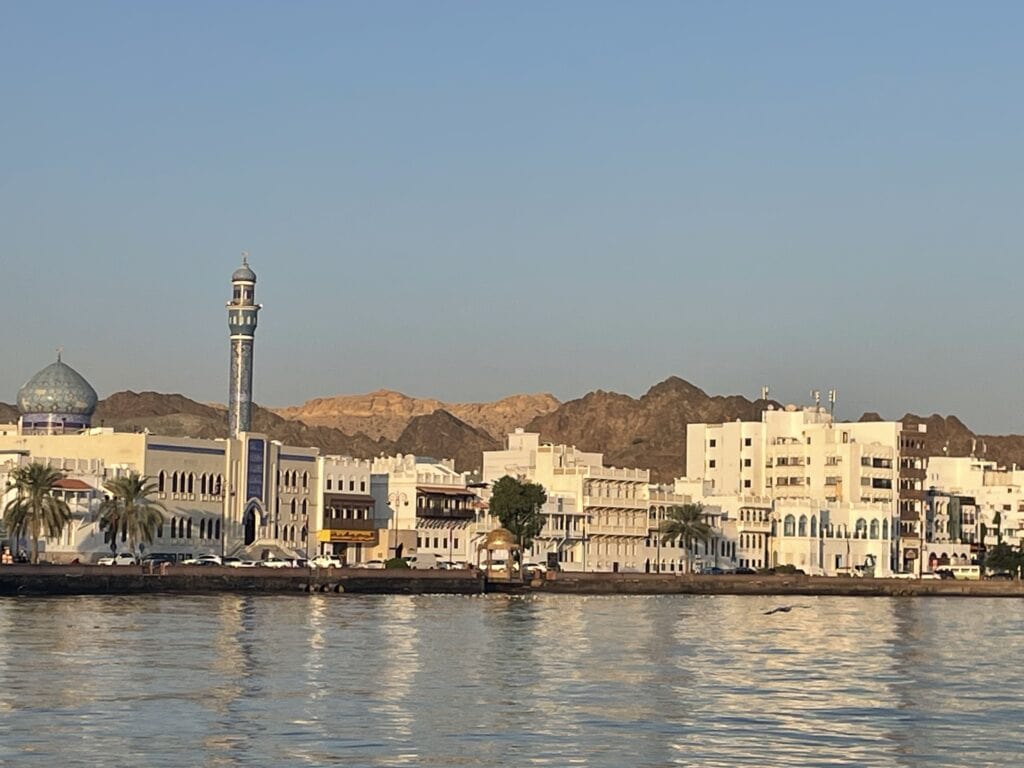
Muscat Itinerary: Bait Al Zubair, Muttrah Souq & Corniche Walk

Muscat Itinerary: Sultan Qaboos Grand Mosque, Alam Palace & Royal Opera House
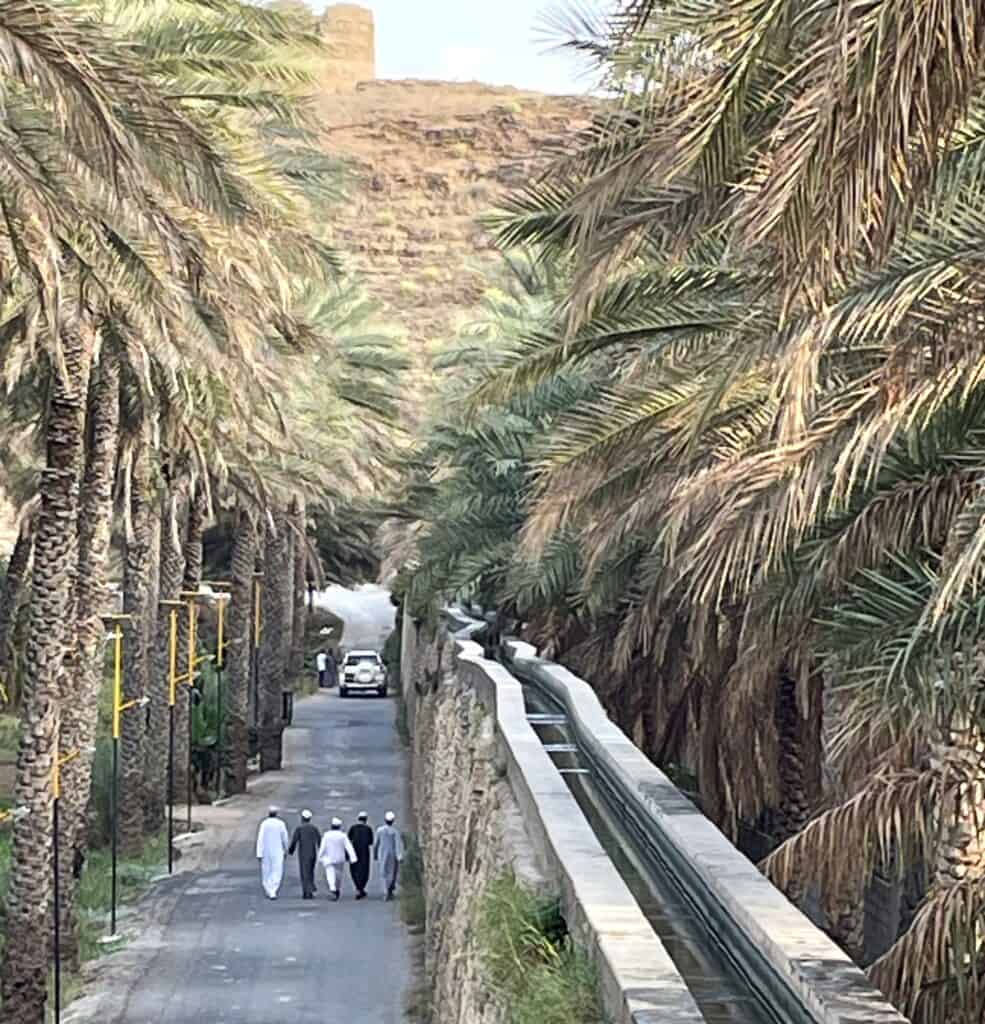
Nizwa & Surrounds Itinerary: Birkat Al Mouz, Oman Across Ages Museum & Nizwa Fort

Nizwa & Mountain Villages: Nizwa Souq, Misfat Al Abriyeen & Jebel Akhdar

Wadis and Desert Itinerary:Wadi Bani Khalid and Wahiba Sands
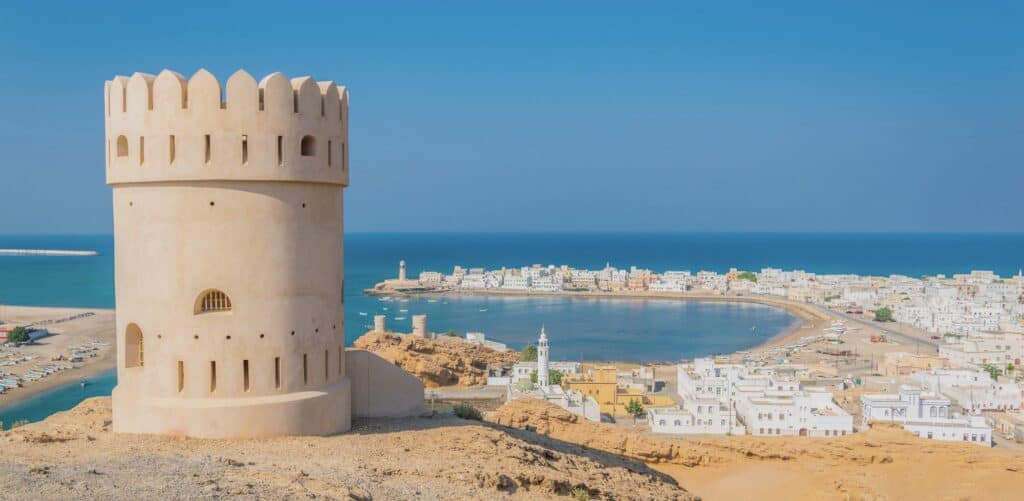
Sur Itinerary: Shipbuilding & Coastal Discoveries at Ras Al Jinz

Coastal Itinerary: Bimmah Sinkhole & Scenic Return to Muscat
Oman is a year-round destination, but the experience changes with the seasons. My personal favourite time is December and January, when the days are sunny and warm (around 22–23°C) — perfect for exploring forts, souqs, and mountain villages in total comfort. November to April is generally ideal for road trips and outdoor adventures across most of the country.
That said, summer has its own charm too — from quiet heritage sites and cooler mountain escapes to hidden wadis and coastal breezes. If you’re visiting between May and September, you’ll just need to plan around the midday heat. I’ve put together a full guide on this: 15 Best Things to Do in Summer in Oman, which shows that there’s plenty to enjoy including the monsoon season in Salalah.
For a detailed breakdown of Oman’s weather by season and region, click here to read my full guide.




Most visitors arrive by air at Muscat International Airport, which has direct flights from major cities across the Gulf, Europe, and Asia, including London, Frankfurt, Istanbul, Dubai, Doha, and Mumbai. (See my post: A Comprehensive Guide to Muscat Airport in 2026 for full details.)
If you’re already in the Gulf, you can also enter Oman by car or bus from the UAE. Driving between Dubai and Muscat takes about 5–6 hours on modern highways — I’ve done this route several times and it’s straightforward, but you’ll need the correct car insurance for border crossing. Long-distance buses, such as those run by Al-Khanjry Transport, connect Dubai, Abu Dhabi, and Sharjah to Muscat in around seven hours.
There are currently no passenger trains into Oman, so air and road travel are your main options. For most 7-day itineraries, I recommend starting and ending your trip in Muscat for the easiest flights and car rentals.

For this 7-day Oman itinerary, the best way to get around is by hiring a car. It’s the easiest way to explore at your own pace and reach places that public transport simply doesn’t go to — like the mountains, wadis, and desert.
Muscat has a reliable city bus network (Mwasalat) and you’ll find taxis in most towns. But having your own vehicle means you can pull over for that unexpected photo stop, linger longer in a souq, or take the scenic mountain road.
I’ve driven all over Oman and it’s easy to navigate, but there are a few things to know before you set off — especially about speed limits and local ‘ways of driving’.
If you’d rather not drive, there are still options. You can arrange private transfers between major destinations or book a driver or guided tours for certain days of the itinerary. These are more expensive but can be worth it if you want a driver who also acts as your local guide.
| Expense Category | Budget Style | Mid-Range Style | Luxury Style | Notes |
|---|---|---|---|---|
| Accommodation (6 nights) | 180 OMR ($468) | 450 OMR ($1,170) | 1,500+ OMR ($3,900+) | Avg. 30/75/250+ OMR per night |
| Car Rental (7 days) | 140 OMR ($364) | 210 OMR ($546) | 350 OMR ($910) | Sedan vs. Mid-size 4x4 vs. Premium 4x4 |
| Fuel (approx. 1500 km) | 25 OMR ($65) | 35 OMR ($91) | 45 OMR ($117) | Includes a buffer for detours & city driving. |
| Food & Drink (7 days) | 100 OMR ($260) | 175 OMR ($455) | 420 OMR ($1,092) | Local cafes vs. hotel restaurants vs. fine dining. |
| Tours & Entrance Fees | 35 OMR ($91) | 40 OMR ($104) | 100 OMR ($260) | Covers all major sites in the itinerary. |
| TOTAL (per person) | ~480 OMR ($1,248) | ~910 OMR ($2,366) | ~2,415+ OMR ($6,279+) |
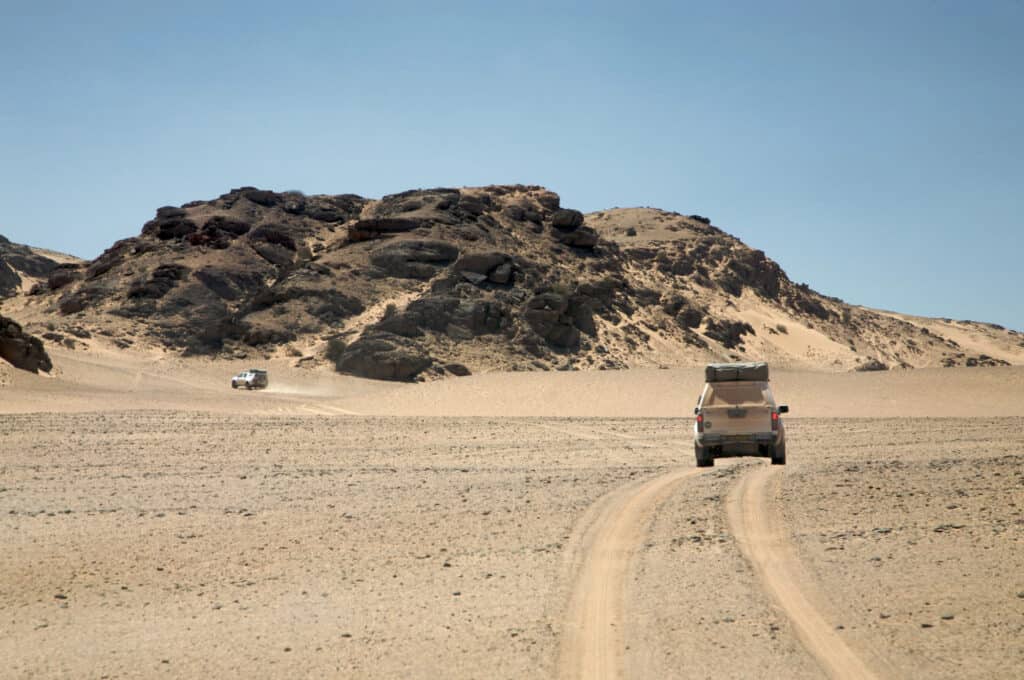
Read my Top Tips for Visiting Oman for the First Time to learn the essential cultural insights, travel advice, and practical know-how you need to explore Oman with confidence.
In this 7-day Oman itinerary, you’ll get a balanced mix of landscapes, culture, and local life — from fishing villages on the coast to sweeping desert dunes, historic forts to mountain viewpoints. Each day includes practical tips, transport advice, and my own tried-and-tested suggestions on where to stay and what not to miss, so you can plan with confidence and enjoy Oman at your own pace.
Most travellers start their Oman adventure by flying into Muscat. Once you arrive, check in to your hotel and get settled before the journey begins.
If you’re coming from the airport, you may want to rent a car there or take a taxi (there’s an O’ Taxi stand right outside the Arrival Terminal). If you’re coming from the Bus Terminal in Ruwi, you’ll need to get a taxi there. Use the O’Taxi app for this.
Budget-friendly: Swiss-Belinn Airport Muscat
(you can see my blogpost on the this hotel to see my full review).
Mid-range: Intercity Hotel Muscat
Luxury: The Chedi Muscat
If you want to consider other options, read my ‘Where to Stay in Muscat in 2025: A Guide to the Best Hotels & Areas – with Map.’
(Click on the icon – the small rectangle – at the top left of the map to access the specific days with the places connected with each.)

DAY 1: THE PLAN
Your first full day in Oman is all about soaking up Muscat’s character — the scents, the colours, the sea breeze, and the easy pace that makes the city so charming. You’ll start the day in a fort (for breakfast!), wander through a private home-turned-museum, and end the afternoon watching the sun disappear into the Gulf of Oman.

There’s no better way to set the tone for your trip than breakfast at Rozna. From the outside, it looks like a small Omani fort, with towers, heavy wooden doors, and clay pots. Step inside and you can either sit in the big central dining hall or slip off your shoes and settle onto the cushions in one of the smaller private rooms — the way many Omanis still like to dine.
Order one of the breakfast trays. They come with fresh Khubz rakhal (paper-thin Omani bread) made right in front of you.
📍 Tip: Rozna opens at 8:00 am, so aim for an early start. It’s located in Al Ghubra, a short drive from central Muscat.

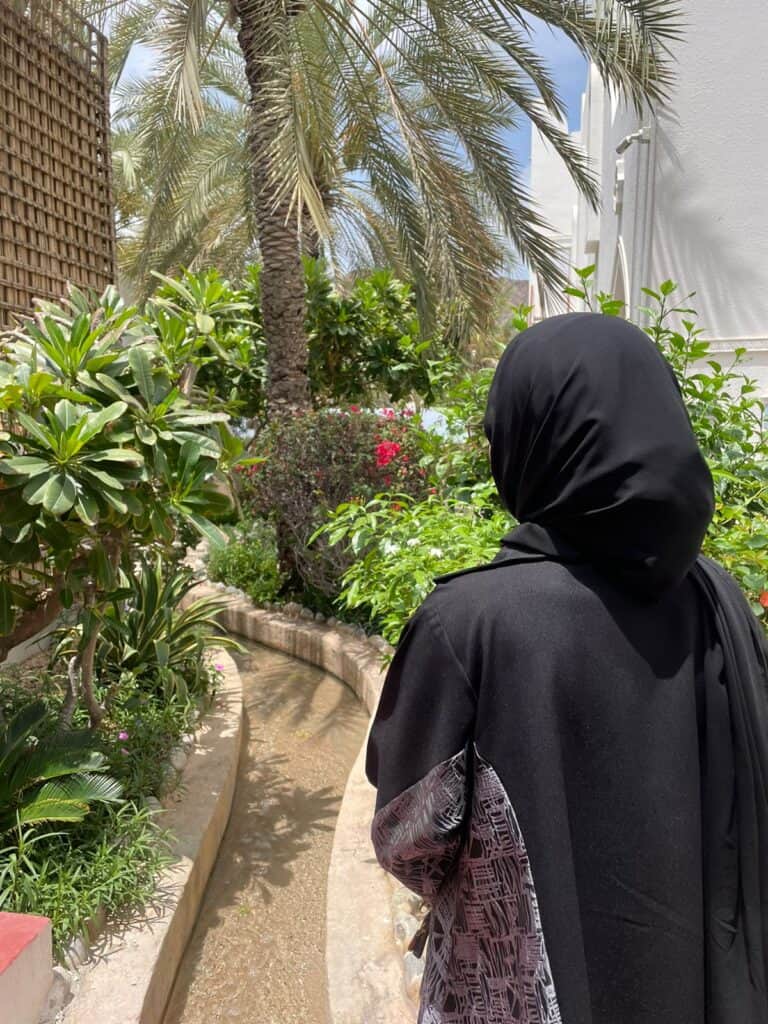
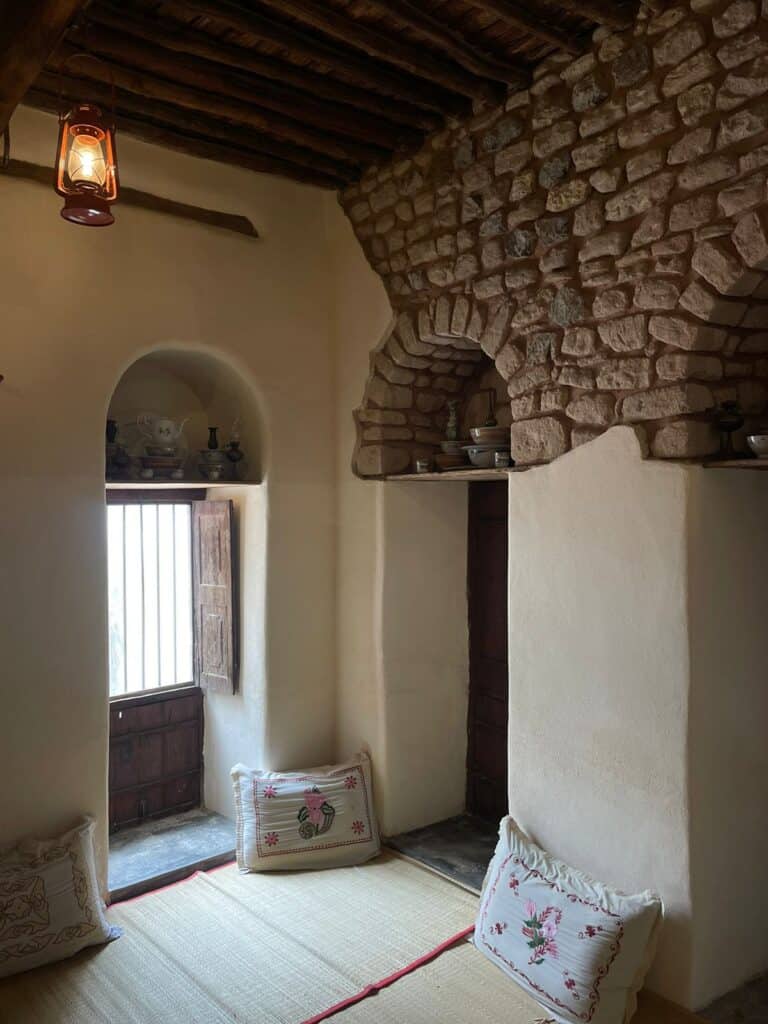

Next, I recommend you head to Bait Al Zubair Museum in Old Muscat. The beautifully restored Omani house showcases traditional clothing, jewellery, weaponry, and everyday objects. It’ll give you a rich cultural context for the rest of your journey.
Don’t miss the courtyard. It features a miniature falaj irrigation system, and the detailed models of forts and old Omani homes.
⏱ Time needed: 1–1.5 hours
📍 Read more in my guide to Bait Al Zubair Museum.
For a midday pause and if you are hungry, I suggest you go to one of my favourite traditional restaurants in Mutrah a few kilometres away from Bait al Zubair.
Bait Al Luban is near the Corniche. Once again, it is set in a traditional décor and the menu offers authentic Omani flavours with sea views. If you are visiting during the winter months, you can sit out on the balcony.

Stroll along the Corniche, watching dhows in the harbour, before diving into Muttrah Souq – one of the oldest markets in the Arab world.
Muttrah Souq opens at 4.00 pm and stays open until around 10.00 pm. There, you’ll find:
🛍️ Tip: Bargaining is expected to a certain degree, so you may want to try your hand at it.
📷 Check out my blogpost on Mutrah Souq to get more information about its history and community connections.
For a peaceful end to the afternoon, walk or drive up to the Riyam Park Viewpoint, where the giant incense burner monument offers sweeping views over the sea and Muttrah.
If you prefer something easier:
Stroll along Al Bahri Road (connecting Muttrah to Old Muscat),
Option 1: Dine at Ramssa Omani restaurant in Al Qurum or, if you prefer more international cuisine, go to Thalassa (Greek restaurant) which offers a beautiful setting near the sea.
Option 2: If you’re staying nearby, relax at your hotel and prepare for an early start the next day.

DAY 2: THE PLAN

Start your day with breakfast at Dukanah Café, a charming spot designed like an old Omani home with mud-brick walls, wooden beams, and traditional seating.
Order the Dukanah Breakfast, a platter of local favourites like shakshuka, lentils, cucumber salad, dates, and fresh cream with warm bread. Don’t miss the cardamom-spiced Omani coffee or Quroos — tiny pancakes drizzled with date syrup.
📍 Tip: Located in Al Ghubrah South, just 10 minutes from Sultan Qaboos Grand Mosque. Parking is easy.
If you want more information about Dukanah Café, read my full review.

One of the most famous places in Muscat is definitely Sultan Qaboos Mosque. It’s open to non-Muslim visitors Sunday to Thursday, 8:00–11:00 AM, so you’ll want to arrive early to make the most of your visit. Be aware that women need to cover their hair, arms, and legs while for men, long trousers and sleeves are required. You’ll also have to remove your shoes before entering the prayer halls.
This isn’t just a quick “snap-and-go” stop. The mosque is huge — five elegant minarets (each one symbolising the Five Pillars of Islam), a handwoven carpet so big it had to be assembled inside (21 tonnes!), and a chandelier that looks like it belongs in a fairy tale, with 34 smaller chandeliers twinkling around it.
Just a short drive from the mosque is the Royal Opera House Muscat, opened in 2011 and blending Islamic and Italian architectural styles. Many guides recommend a paid tour, but when I went, it lasted all of eight minutes (yes, I timed it!). Instead, if there’s an evening performance, go for that — you’ll get to see the show AND the elegant lobby and grand hall with its ornate balconies in their full glory.
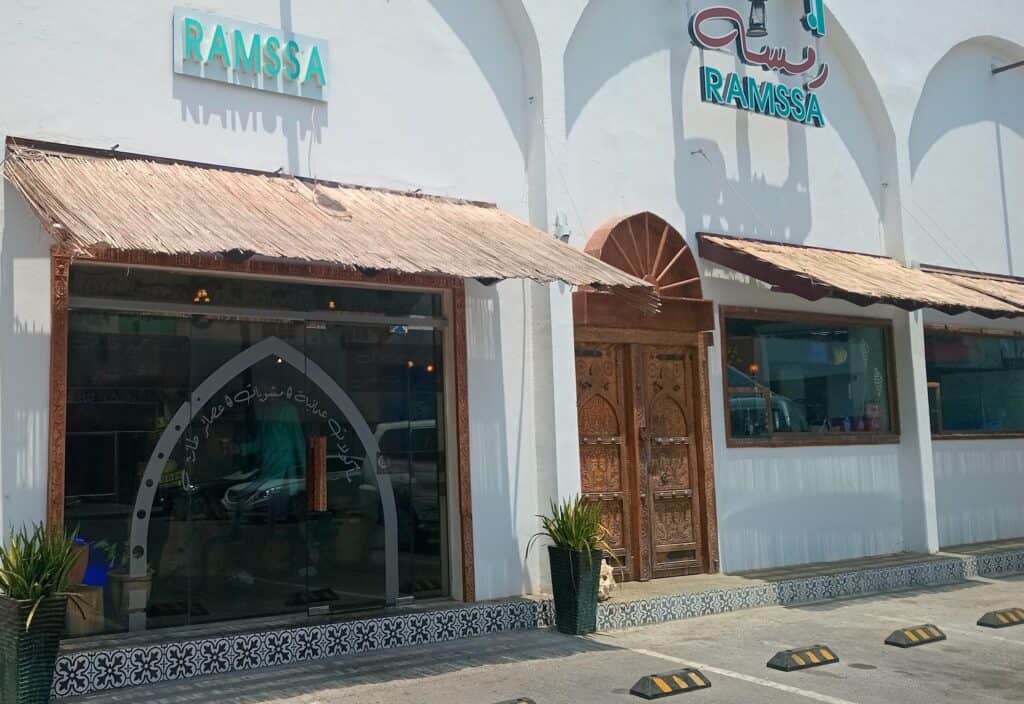
After visiting the mosque, you might be ready for lunch. Two nearby restaurants give you a taste of Omani cuisine in different ways. Ubhar puts a modern spin on classics, serving dishes like Shuwa wraps and even frankincense ice cream. Ramssa Omani Restaurant, on the other hand, offers a cosy, heritage-style setting with traditional favourites such as Majboos and grilled mishkak. (See my full review of Ramssa here.)
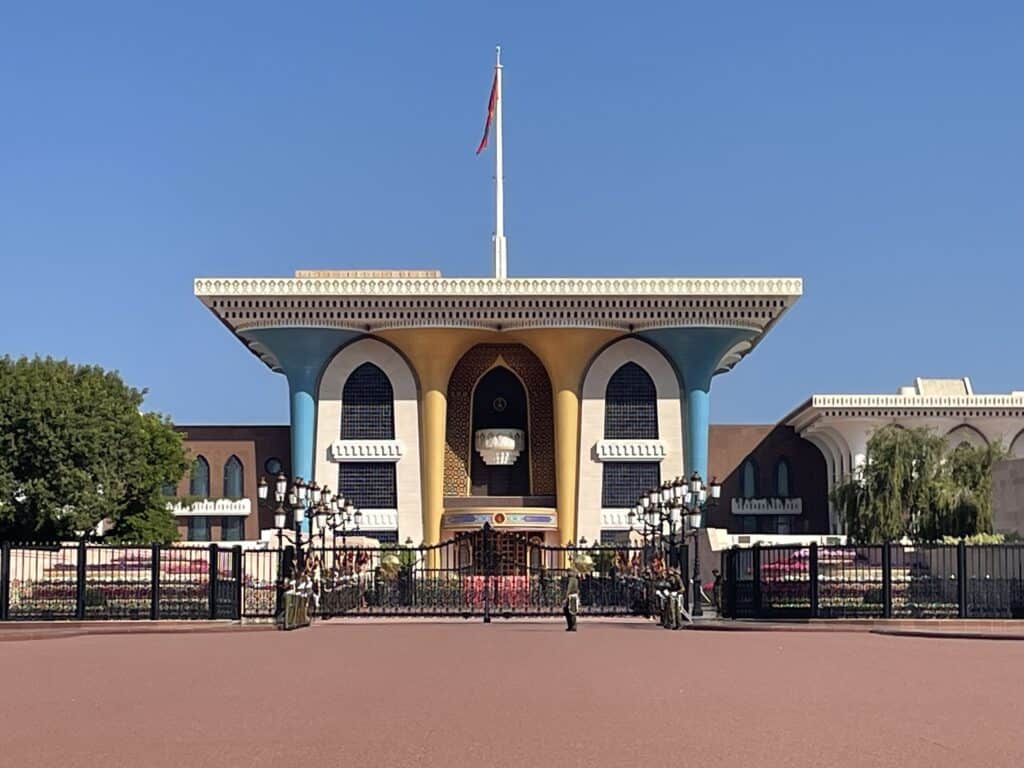
Al Alam Palace, one of the six royal residences of His Majesty the Sultan, is as striking in real life as it looks in photos. The first time I saw it, I couldn’t stop staring at the blue-and-gold façade – it feels both regal and original, a bold twist on contemporary Islamic design.
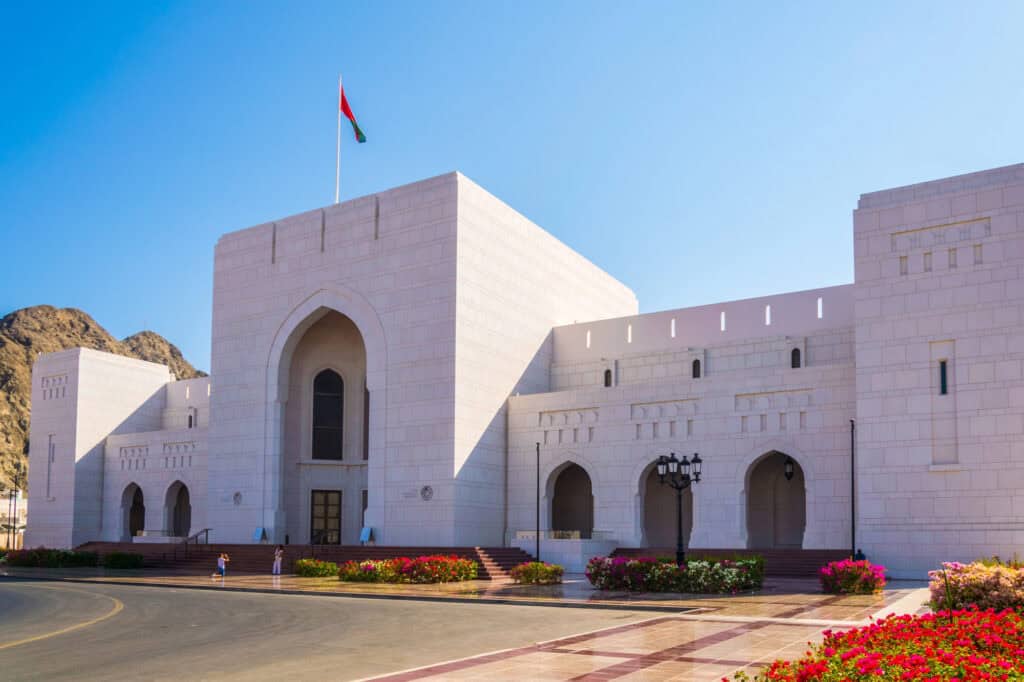
The National Museum. opened in 2016 and located opposite Al Alam Palace, is an essential stop if it’s your first time in Oman. I recommend beginning with the documentary Oman: The Jewel of the East in the Land of Hope, shown in English and Arabic in the ground-floor AV Theatre, as it gives a beautiful, immersive introduction to the country’s history and heritage.
Interesting fact: The National Museum of Muscat was the first museum in the Middle East to incorporate Arabic Braille script throughout its exhibits
Location: As-Sa‘idyyah Street
Ticket Prices:
Omani citizens and GCC nationals: 1.000 OMR (with valid ID)
Residents: 2.000 OMR (with valid resident card)
Tourists: 5.000 OM
Saturday to Thursday: 10:00 AM – 5:00 PM
Ticket desk closes at 4:30 PM
Friday: 2:00 PM – 6:00 PM
Ticket desk closes at 5:30 PM
Option 1: A dhow cruise along Muscat’s coastline is a magical way to end your second day in Oman.
Departing from Marina Bandar Al Rowdha, these traditional wooden boats will take you past the cliffs and the bays of Muscat. Marina Bandar Al Rowdha is about 5 to 10 minutes driving distance from the National Museum.
Most cruises last around 2 hours and typically include a buffet dinner and refreshments. Prices start at around 20 OMR per person, with evening departures usually around 5:30 to 6:00 p.m.
For more information, check out: Star of The Sea Oman
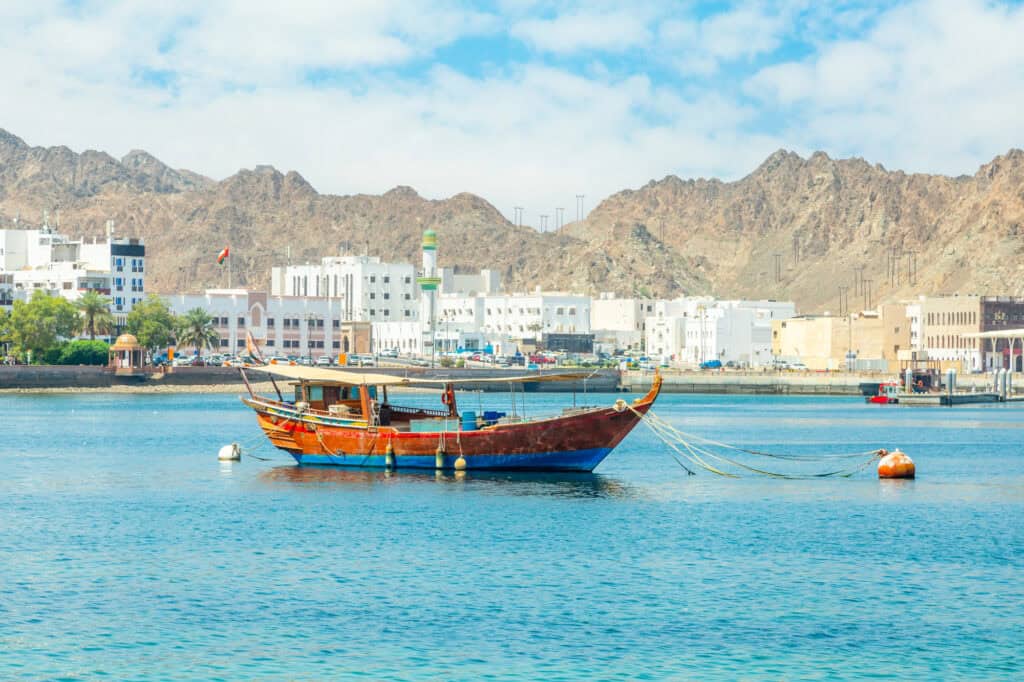
Option 2:
Another suggestion is attending a performance at the Royal Opera House if there is a show. Located in the Shati Al Qurum district, the Opera House showcases a diverse array of performances, including opera, ballet, and classical concerts, with evening shows typically starting between 7:00 and 8:00 p.m.
For the latest performance schedule and to make reservations, you can visit the Royal Opera House Muscat’s official website rohmuscat.org.om
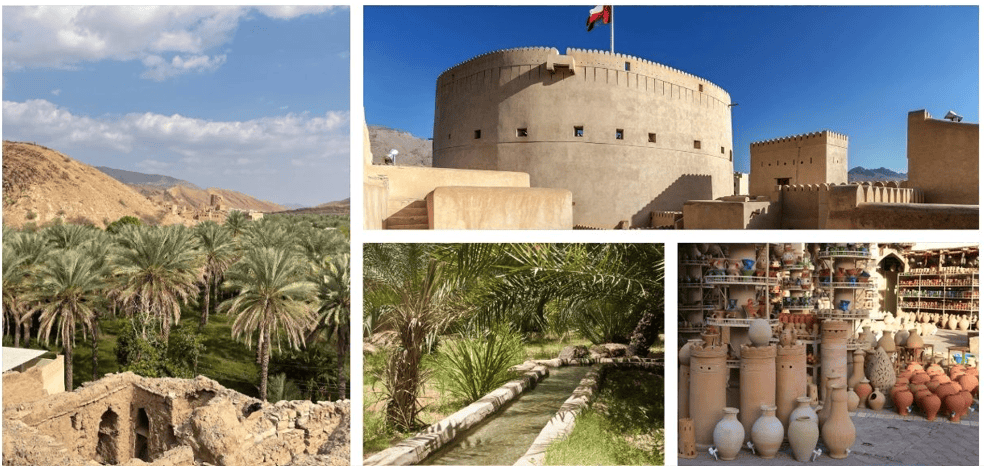
DAY 3: THE PLAN
On your third day, you’ll leave Muscat behind and head inland towards Nizwa, Oman’s cultural heart. Along the way, you’ll stop at Birkat al Mouz — a mud-brick village surrounded by lush palm groves — explore the brand-new Oman Across Ages Museum in Manah, and finish with a visit to Nizwa Fort, one of the country’s most iconic landmarks. I recommend staying overnight in Nizwa so you can catch the souq at its busiest the next morning.
Important TIP: Before you head out on your road trip, take a few minutes to download the area of Oman you’ll be driving through on Google Maps so it’s available offline. Phone signal can be patchy in the mountains or the desert. So having offline maps is a lifesaver.
Budget-friendly: IHYAA Inn. central, just 300m from Nizwa Fort, with friendly staff, free parking, and very clean rooms (though some don’t have windows).
Mid-range: Intercity Hotel Nizwa. modern, newly opened, with comfortable rooms and a swimming pool to cool off in after sightseeing.
After three nights in Muscat, set off towards Nizwa (about 1.5 hours by car) and break your journey at Birkat al Mouz. This atmospheric mud-brick village sits at the foot of the mountains and is known for its beautiful date plantations.
I like to stop at Al Alam Café for coffee before wandering into the old neighbourhood of Harat As Sibani. Another good option is Banana Café, where you can sip your espresso overlooking the palm groves.
Then, lose yourself in Birkat’s narrow alleyways. Climb up to the remains of the watchtower for views (don’t wear heels when you do it!), and take time to notice the traditional falaj irrigation channels. Birkat al Mouz is often skipped on tours, but in my opinion, it offers one of the best glimpses into traditional Omani village life.
For a ‘step-by-step guide around Birkat’ and more tips, you can have a look at my blogpost.
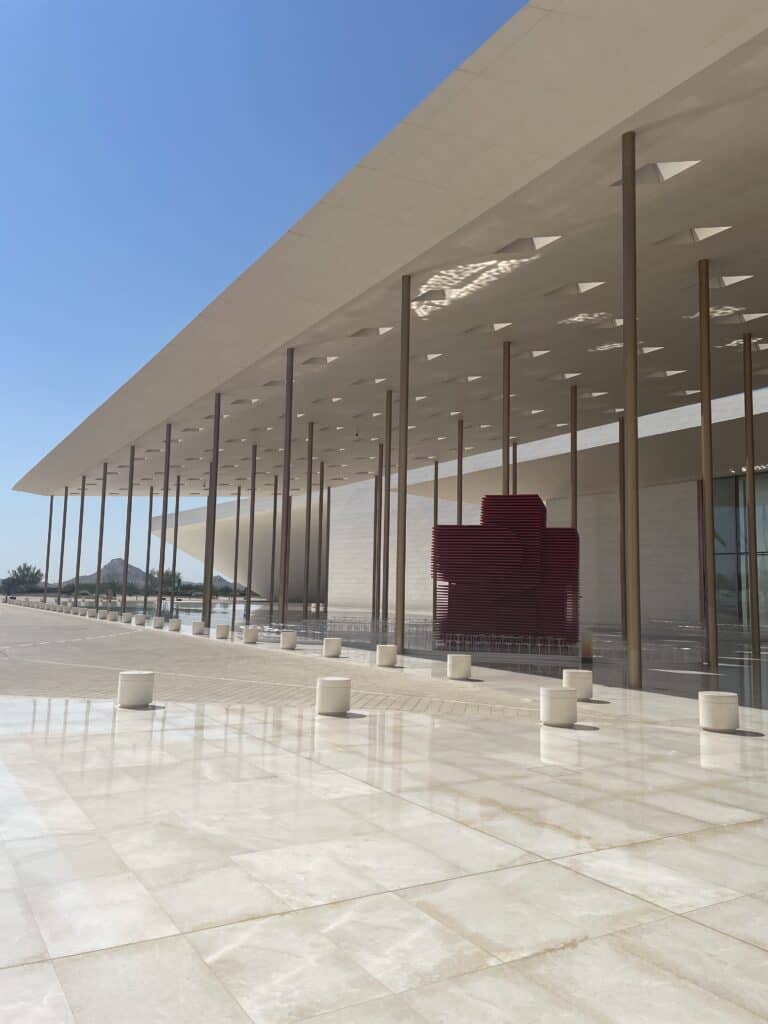

From Birkat, it’s a 30-minute drive to Manah, where the Oman Across Ages Museum opened recently. The striking building reflects Oman’s rugged mountain landscapes and houses wonderful interactive exhibits on the country’s past and present.
Trace Oman’s history from the Bronze Age to the modern renaissance. Don’t miss the life-sized Magan Boat reconstruction. I’m warning you: it’s a huge museum on several levels!
There are cafés on site if you need lunch or a coffee break. Plan to spend at least two hours here — comfortable shoes are a must.

End the day in Nizwa, just 30 minutes away. Before heading into the fort, stroll through the restored old quarter, where crumbling houses have been carefully brought back to life. When I first lived in Nizwa, much of this area was in ruins — it’s wonderful to see it thriving.
Nizwa Fort itself never disappoints. I’ve been there (literally) tens of times. Built in the 17th century, inside, you’ll find twisting staircases, hidden chambers, and clever defence features like the famous “murder holes” — once used to pour boiling date syrup on attackers.! From the top, enjoy sweeping views over the palm groves and mountains.
Practical tip: pop into the small souvenir shop for locally made perfumes or natural skincare, and grab a quick “Omani sandwich” (flatbread with cream cheese and ‘Omani Chips’) in the courtyard.
Nizwa Fort is now open from 8:00 AM to 8:00 PM daily, with a midday break on Fridays from 11:30 AM to 1:30 PM . This schedule allows for an early evening visit, offering the opportunity to explore the fort as the day cools.
Evening: Dinner in a Local Restaurant or Return to Hotel
Option 1: Wander down to Liwan Nizwa Restaurant, which is about 8-10 minutes walk from Nizwa Fort. They serve a good range of dishes and the food is excellent. In the winter months, you can sit outside on their large terrace.
Option 2: Go back to your hotel and have a restful evening. Tomorrow, you’ll need to get up really early if you want to catch a glimpse of Nizwa Souq in ‘full swing.’

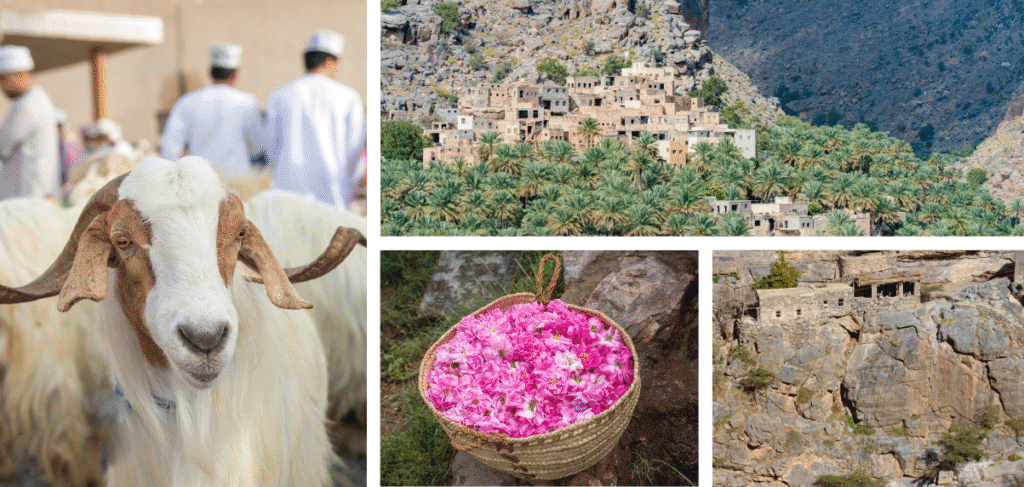

DAY 4: THE PLAN
On the fourth day of your itinerary, you’ll start with an early visit to Nizwa Souq, one of Oman’s oldest and most atmospheric markets. If it’s a Friday, you’ll catch the lively livestock market, a chaotic and fascinating glimpse into traditional Omani life. After soaking up the sounds and scents of the souq, you’ll head to Misfat al Abriyeen, a 300-year-old mountain village known for its winding stone alleys, lush terraces, and ancient falaj irrigation channels. From there, you’ll drive up to Jabal Akhdar, where cooler mountain air and dramatic canyon views await – the perfect way to end a day of exploring Oman’s past and present.
I suggest you stay in Jabel Akdar to enjoy the mountain views and atmosphere.
Keeep in mind: Jabal Al Akhdar requires a 4WD vehicle to access its steep, winding roads, and there is a police checkpoint at the base to ensure this rule is followed. If you don’t have a 4WD, you can either rent one in Muscat or Nizwa, or consider hiring a driver to get there. Some hotels and tour companies also offer transfers, which can be a convenient way to reach this stunning mountain region.
Luxury: Anantara Resort. Perched on the edge of a canyon, it offers magnificent views in total comfort. It is the highest 5-star resort in the Middle East.
Wild Camping: For a more budget-friendly option, you can wild camp in Jabal Akhdar. It’s a chance to wake up to the mountain air and the panoramic views. But keep in mind that temperatures can drop sharply at night, and you’ll need to bring all your gear (or rent it), including water and a sturdy tent.
For a Once-in-a-Life Experience: Suwgra Heritage Inn. This is like stepping back in time – this hotel, carved into the mountainside, offers a truly unique experience with its cliffside rooms, panoramic canyon views, and authentic Omani food. It does require a short walk to get to it.
Mid-range: Sama Hotel Jabal Al Akhdar. Once again, superb views with clean rooms and good value for money. It even has a heated swimming pool!

It’s worth getting up early to catch the opening of Nizwa Souq when the stalls come to life with the sounds of traders setting up and the first customers of the day haggling over fresh produce, spices, and handmade crafts.. Nizwa Souq opens daily, typically starting around 8:30–9:00 AM and operating until approximately 12:30 PM.
If possible, try to plan your Day 4 for a Friday, so you can experience the famous livestock market at Nizwa Souq, where local farmers auction off goats, cattle, and sheep – a tradition that has been part of Omani life for centuries. Auctions in the goat market start around 7.00 AM and will offer you a unique cultural experience. It’s always very crowded with owners parading their animals as locals watch in line and bid.
In the fruit and vegetable market, you’ll notice that the ‘system’ is different than in other markets. Produce tends to be sold in an auction-style way with people bidding. You may also want to wander over to the ‘Firearms market’, right beside the entrance of the Souq. It will give you a chance to see a lot of Omani Khanjar (traditional daggers). You’ll also find a lot of pottery and handicrafts for sale in the Souq.
To follow a complete guide on Nizwa Souq – with tips from a local, be sure to read my blogpost.
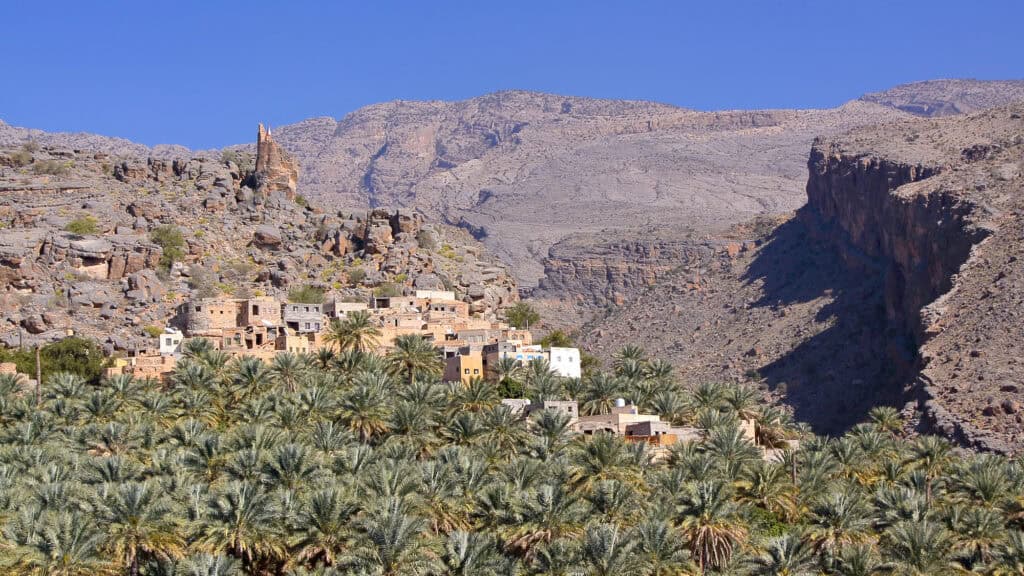
The drive from Nizwa to Misfat Al Abriyeen typically takes between 40 to 55 minutes, depending on traffic and road conditions. The distance is approximately 47 kilometers (about 29 miles), and the route is fully paved, making it accessible with a standard vehicle – no need for a 4WD.
You will need to park your car in the small gravel lot at the entrance or along the road that leads to Misfat – you can’t drive inside the village.
When you first arrive in Misfat al Abriyeen, you will feel like you have stumbled into a different era. The village is a maze of narrow alleys, shaded by overhanging palm fronds, and its ancient mud-brick houses cling to the mountain slopes. The whole experience (because Misfat IS an experience!) is very peaceful with views over the valley and palm groves that are incredible!
I suggest you have lunch in one of the restaurants in Misfat al Abriyeen. For breathtaking views and a unique experience climbing up the stone stairs, I would recommend Bun Al Hisn Café, which is at the entrance of the village. Just make sure you don’t bang your head while going up or down!
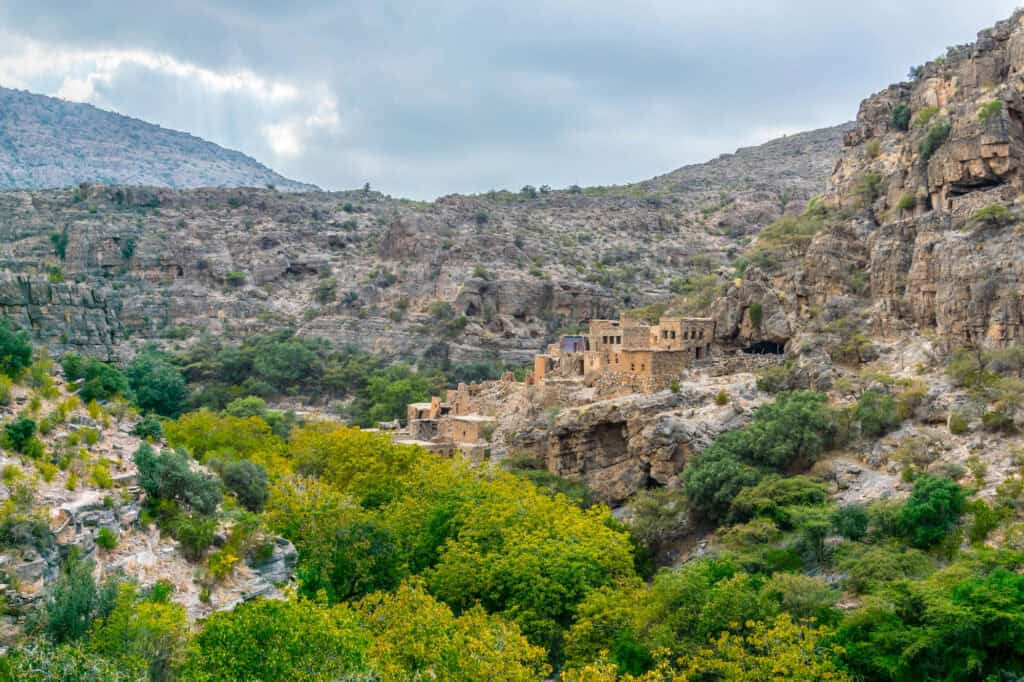
As you will see very quickly, visiting Jabel Al Akhdar is all about slowing down and soaking in the mountain air. The drive up is steep and you’ll need a 4WD to get through the checkpoint – no exceptions – so either rent one or book a tour.
Take some time to check into your hotel and settle in.
If you’re staying at the Suwgra Heritage Inn (see before for recommended accommodation), it will take you about 15 minutes to walk up to the inn. Once you’re there, you may simply wish to take it easy and enjoy the stunning location.
However, if you wish to explore the area, here are some options.
Start at Al Ayn Village
Head to Al Ayn, a small mountain village known for:
Traditional stone houses
Dramatic terraced fields
Rose gardens (best in bloom from March to April)
If you’re lucky enough to visit during rose season, you might spot locals making rose water the traditional way using large clay pots.
Walk the Trail to Al Aqur
From Al Ayn, take the easy walking trail to the nearby village of Al Aqur. It’s a relaxed walk with:
Stunning views over the canyon
Ancient falaj irrigation channels
Quiet moments between orchards and old homes
🟠 Tips: Wear proper walking shoes and carry water. There’s little shade, and it can get hot during the afternoon.
In the evening, have dinner at the hotel and enjoy the stunning sunsets you get in this part of the world. The following video from the ‘Side Trip of a LifeTime’ Youtube channel will give you an idea…
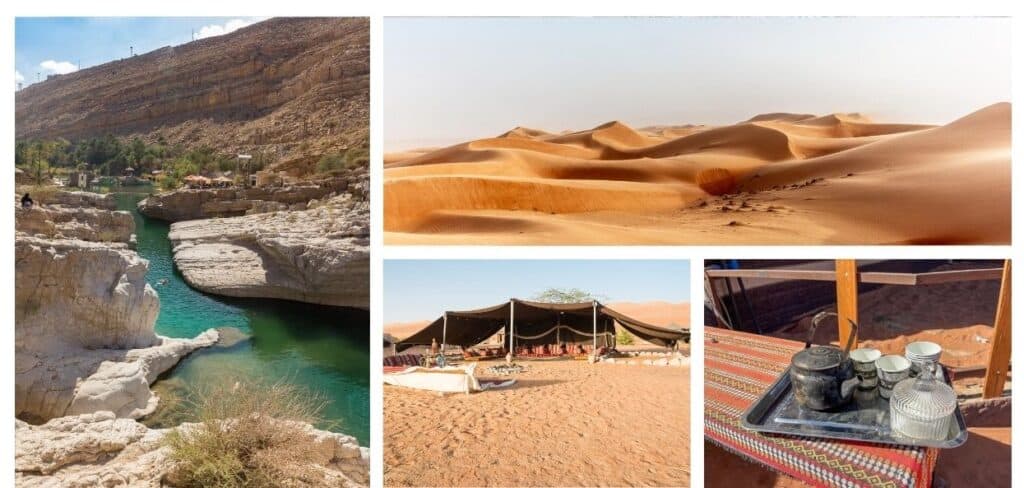
DAY 5: THE PLAN
On the fifth day of your journey, you’ll trade the cool mountain air for the dramatic landscapes of Oman’s desert region. Begin with a stop at Wadi Bani Khalid, one of the country’s most famous wadis, where turquoise pools, palm groves, and rocky cliffs meet. After a swim or a walk along the falaj channels, continue towards the golden dunes of Wahiba Sands. In the afternoon, you’ll check into one of the desert camps in Wahiba Sands, where endless sandscapes, starlit skies, and traditional Omani hospitality combine for an unforgettable night in the heart of the desert.
Important tip: Driving in the desert requires a 4WD and experience of this type of terrain. I recommend you arrange for someone from your desert camp to come and pick you up.
Luxury: FYAFY Bidiyah Bedouin Camp
A peaceful luxury retreat with just three tents, making it feel private and exclusive. Expect fine dining, sunset drives, and attentive service. Perfect if you want comfort paired with a unique desert experience.
Mid-range: Authentic Desert Camp – Al Wasil
A small and secluded camp with a very welcoming host and elegant tents. Meals are delicious and traditional (this is your chance to try camel meat!). You can also enjoy dune bashing and Bedouin dance performances.#
Budget-friendly: Wahiba Bedouin Rustic Camp
This camp is simple but comfortable, with the choice of a room or a tent with a private bathroom. Run by a Bedouin family, it’s all about hospitality: expect traditional stories around the campfire, camel rides, and more.
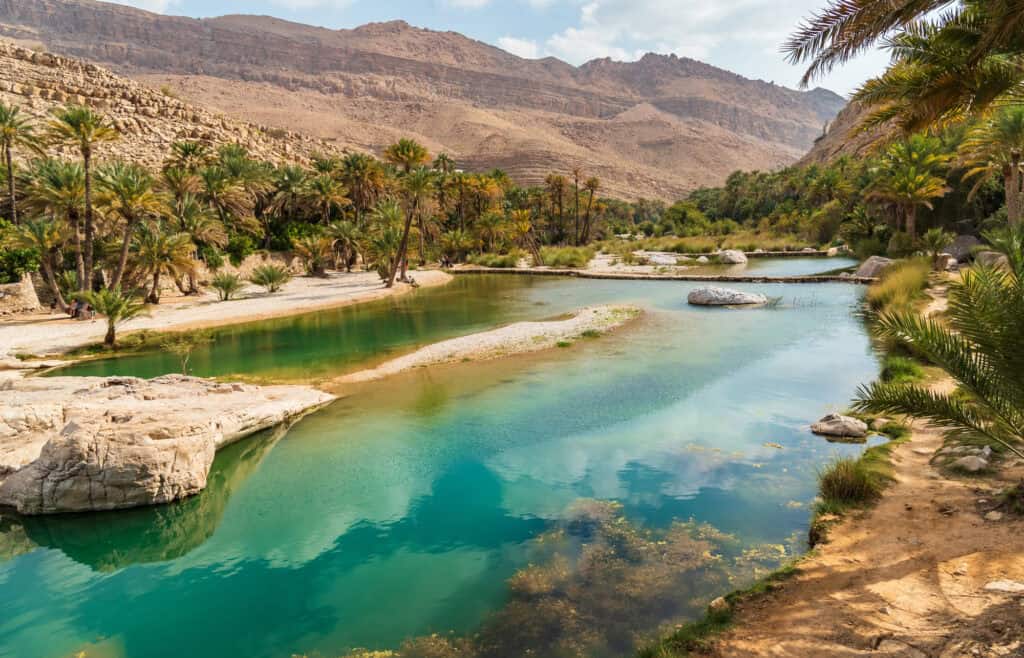
After days of forts, mountains, and souqs, it’s time to cool off in one of Oman’s natural swimming spots. A wadi is essentially a valley or riverbed that often hides sparkling pools and shady palm groves, and Wadi Bani Khalid is among the most beautiful — and most accessible — of them all. From the car park, it’s only a five-minute walk to reach turquoise pools where you can dive in straight away. These first pools are easy to enjoy but do come with a more commercial feel, with paved paths, a café, and picnic areas nearby.
Do keep in mind that wadis can flood quickly, so it’s important not to visit if there’s any chance of rain.
Just beyond the main pools lies Muqal Cave, where cool water echoes through narrow stone chambers. It’s an atmospheric spot to peek into, but the rocks can be slippery and it’s very dark inside — bring good shoes and a torch if you’re tempted to explore.
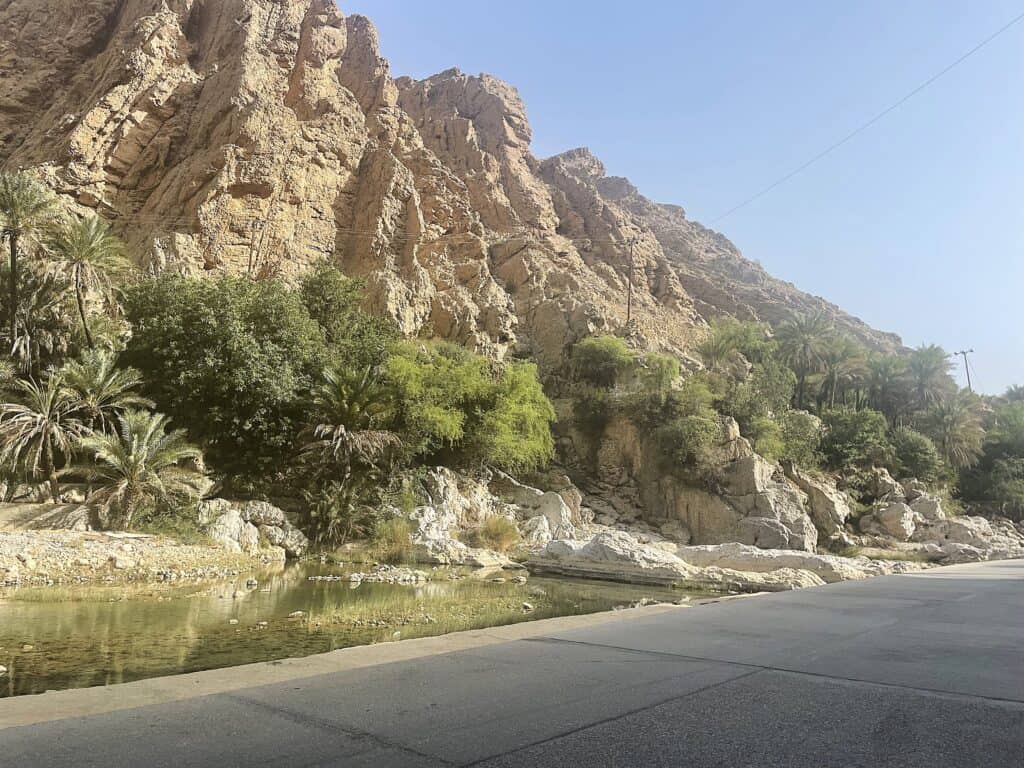
From the cool waters of Wadi Bani Khalid, you now need to head back into the desert (it’s about 60 to 80 kilometres away). It is best to set up a meeting place with the host of your desert camp.
You’ll arrive at Wahiba Sands and check into your room or tent in the desert camp. Watching the sunset here is unforgettable — the sand glows orange and pink as far as the eye can see, and the stillness is powerful (I don’t know how else to describe it!). After dinner, you can sit by the fire under a sky crowded with stars. When I stay in the desert, I love discovering the stories and traditions of my Bedouin hosts. Spending the night in the desert is one of those experiences that stays with you long after your trip is over.


DAY 6: THE PLAN
On the sixth day of your adventure, you’ll leave the golden dunes of Wahiba Sands and drive about 150 kilometers toward the coastal town of Sur.
After a night under desert stars, your journey will take you back to the sea. The town of Sur always appears to me like a little jewel with its white lighthouse and picturesque bay. Dhow shipyards, waterfront strolls, and traditional Omani meals wait for you to enjoy.
In the afternoon, you’ll continue on to Ras al Jinz, where you’ll stay overnight and witness turtles nesting on the beach – a special experience that will connect you with Oman’s unique environment.
Practical tip: Driving out of the desert requires a 4WD and experience on sand tracks. To make the journey easier, I recommend arranging for someone from your desert camp to bring you back to the main road before continuing on to Sur.
Mid-range: Sama Ras Al Jinz Resort. Simple but charming accommodation in individual chalets. Each one with a little terrace. 5 minutes drive to the Turtle Reserve. Good breakfast buffet.


You will have breakfast in the desert and then set off for Sur. Once you arrive, you can enjoy a coffee and a ‘snack’ at Al Hawash Restaurant, Why not try try their lola (very addictive! Beware!)? Lightly fried puffed up ‘bread’ made from flour, eggs, and a hint of sugar, served warm with honey or date syrup. They’re simple but delicious, and the best part is enjoying them while looking out over the beach and the bay from the restaurant’s windows!
After the snack, you can take a slow stroll along the sand, stop by the white lighthouse that keeps watch over the small harbour, and then head to the dhow shipyard, where craftsmen still shape the great wooden boats that carried Oman’s seafaring tradition across the seas.
In the afternoon, make your way from Sur to Ras al Jinz, where you’ll check into the hotel right by the Turtle Reserve — staying here makes the evening programme easy and stress-free.
After settling in, join the reserve’s guided night tour to the beach, the only official way to see the turtles nesting. Tours usually start after 9 p.m. and are run by trained guides who ensure both visitors and turtles are respected. The main nesting season for green turtles is from July to October, but hatchlings can sometimes be seen up to January, depending on conditions.
I went in August and was lucky to see tiny hatchlings making their first dash to the sea under the stars.
Tip: Be sure to wear comfortable shoes for walking on sand, avoid flash photography, and bring a light jacket — it can feel surprisingly cool or windy at night by the ocean.


DAY 7: THE PLAN
Leaving Ras al Jinz after an unforgettable night with the turtles, the drive back toward Muscat offers one more stop you really shouldn’t miss: Bimmah Sinkhole.
Locals sometimes call it Hawiyat Najm, which means “the Falling Star,” because of an old legend that a meteor created this dramatic limestone crater. In reality, it was formed by the collapse of an underground cavern—but the turquoise water sparkling at the bottom still feels magical! I love how easy it is to get there – it’s just a short walk from the car park – and slipping into the cool, clear water is the perfect way to refresh before the final stretch of the drive.

After your swim at Bimmah, continue the drive north along the coast until Muscat comes back into view.
Depending on your schedule, you might spend a final evening in the capital — picking up a few last-minute souvenirs at Muttrah Souq or one of the malls. Or you might enjoying a relaxed dinner.
Some of you will need to head straight to the airport for your flight home.
Either way, the journey from the desert dunes to the turtle beaches and back to the city completes a circle of Oman’s landscapes and traditions.
In just seven days, you’ll have traced Oman’s contrasts —from rugged mountains and golden dunes to fishing villages and turquoise seas — an itinerary that captures the country’s landscapes, traditions, and unforgettable sense of place.
If you have any questions, post them in the comment box below and I will get back to you. And share this with any of your friends planning a trip to Oman!
One week is perfect to give you an introduction to northern Oman. This 7-day itinerary covers the cultural heart of Muscat and Nizwa, the cool mountain heights of Jebel Akhdar, the golden dunes of the Wahiba Sands, and the beautiful coastline. While you could spend months exploring, this trip gives you a fantastic and memorable taste of the country’s diverse landscapes.
es, Oman is widely regarded as one of the safest countries in the Middle East and the world. The crime rate is very low, and Omanis are known for their hospitality and respect towards visitors. Solo female travellers will generally feel very comfortable here, though it is always wise to dress modestly (covering shoulders and knees) out of respect for the local culture, especially when visiting mosques and villages.
Modesty is key. For both men and women, lightweight, loose-fitting clothing that covers your shoulders and knees is recommended for most situations. When visiting the Sultan Qaboos Grand Mosque, women will need to cover their hair, arms, and legs completely. For men, long trousers are required. In private resorts or at Wadi Bani Khalid, swimwear is acceptable, but it’s respectful to cover up when walking around. Pack layers, as the mountains can be cool, especially at night.
As of 2025, citizens of over 100 countries (including the UK, EU, USA, Canada, and Australia) can enter Oman visa-free for stays of up to 14 days. Since this itinerary is for 7 days, you likely won’t need a visa, but always check the latest requirements on the Royal Oman Police official e-visa website before you travel, as regulations can change.
Alcohol is available, but its sale and consumption are restricted. You can find it in licensed hotels, resorts, and specific restaurants. It is illegal to drink alcohol in public places or to be publicly intoxicated. This itinerary includes several luxury and mid-range hotels where you will be able to have a drink with dinner.

Hi, I’m Christine, founder of Joussour to Oman. After living here for over four years and travelling widely – from desert camps to mountain villages – I created this blog to share practical guides and honest tips based on real experience. My goal is to help you discover the real Oman, beyond the tourist trails.